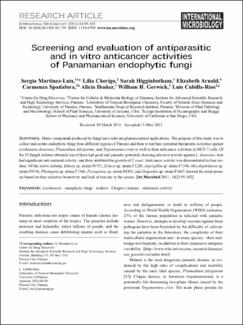Screening and evaluation of antiparasitic and in vitro anticancer activities of Panamanian endophytic fungi
Fecha
2011-06-14Autor
Martínez, Sergio Luis
Cherigo, Lilia
Higginbotham, Sarah
Arnold, Elizabeth
Spadafora, Carmenza
Ibañez, Alicia
Gerwick, William H.
Cubilla-Rios, Luis
Metadatos
Mostrar el registro completo del ítemResumen
Parasitic infections are major causes of human chronic diseases in most countries of the tropics. The parasites include protozoa and helminths, infect billions of people, and the resulting diseases cause debilitating injuries such as blind ness and disfigurement, or death in millions of people. According to World Health Organization (WHO) estimates, 25% of the human population is infected with parasitic worms. However, attempts to develop vaccines against these pathogens have been frustrated by the difficulty of cultivating the parasites in the laboratory, the complexity of their multicellular organization and—in many species—their multistage development, in addition to their impressive antigenic variability [http://www.who.int/vaccine_research/diseases/ soa_parasitic/en/index.html]. Malaria is the most dangerous parasitic disease, as evidenced by the high rates of complications and mortality caused by the most fatal species, Plasmodium falciparum [15]. Chagas disease, or American trypanosomiasis, is a potentially life-threatening two-phase illness caused by the protozoan Trypanosoma cruzi. The acute phase persists for about two months after infection; symptoms are absent or mild and can include fever, headache, enlarged lymph glands, pallor, muscle pain, difficulty in breathing, swelling, and abdominal or chest pain. In the chronic phase, the parasites reside mainly in the heart and digestive muscle, resulting in cardiac disorders in up to 30% of patients and digestive, neurological, or mixed pathologies in up to 10%. Eventually, the infection can lead to sudden death or heart failure, caused by progressive destruction of cardiac muscle [10,15]. Leishmaniasis, a worldwide disease, is caused by several species of the flagellated protozoan parasite Leishmania. In its more severe forms, the disease causes serious disfigurement and may be fatal. The WHO estimates a worldwide prevalence of leishmaniasis of approximately 12 million cases, with an annual mortality of about 60,000 and approximately 350 million people at risk. The expansion of leishmaniasis and the alarming rise in the number of cases has been attributed to environmental changes, such as deforestation, dam construction, new irrigation schemes, and the migration of non-immune individuals to endemic areas [10,15]. At the same time, the frequency of drug-resistant parasites has greatly increased and most treatments involve highly toxic drugs. In addition, the chemotherapeutic agents used in patients with these diseases have lacked effectiveness. Thus, there is an urgent need to search for novel drugs from previously unexplored sources, including natural products, to combat the global health problems posed by parasitic infections. Cancer is another major cause of mortality worldwide; in 2008, it accounted for 7.6 million deaths. According to WHO forecasts, an increase to 11 million deaths annually is expected by 2030. The prevalence is higher in low and middle-income countries. As a part of the on-going research activities, the Panamanian International Cooperative Biodiversity Group (ICBG) [17] recently decided to explore endophytic fungi as a source of molecules with antiparasitic and anticancer bioactivities [18,21,22]. Within the ICBG program, we have assayed the antiparasitic and in vitro anticancer activities of 25 isolates, while also analyzing the effect of the culture medium on the production of secondary metabolites by Panamanian endophytic fungi. The results of these studies are reported and discussed herein

